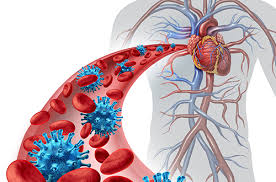What Are Bloodborne Pathogens?Potential contact with another person’s blood or bodily fluids should warrant extreme precautions. These precautions are needed due to the inherent risk posed by bloodborne pathogens in which microorganisms capable of transmitting bloodborne diseases such as human immunodeficiency virus (HIV) and Hepatitis B (HBV). So what exactly are bloodborne pathogens? Bloodborne pathogens are microorganisms in human blood and other bodily fluids that can spread infectious bloodborne diseases. These diseases are spread through contact with infected materials such as contaminated needles, through an open wound, mucous membranes, or damaged tissues. Three Common Bloodborne DiseasesOf the 20 bloodborne pathogens known to cause diseases such as malaria, syphilis, and hemorrhagic fever, there are three; hepatitis B (HBV), hepatitis C virus (HCV), and human immunodeficiency virus (HIV) that are the most common pathogens of concern. These three viruses account for the majority of occupationally-acquired infections and are associated with significant morbidity and mortality. Hepatitis C: Hepatitis C (HCV) is an infection that affects the liver, spread by contact with an infected individual’s blood. HCV can be a short-term illness for some, but for others, it can result in a long-term illness or even lead to life-threatening conditions including cirrhosis or liver cancer. If it is detected early, HCV is treatable. However, symptoms often do not become apparent until the infection has progressed into advanced liver disease. There is no vaccine for HCV, so the best way to avoid contracting it is by avoiding contact with infected blood. Hepatitis B: Hepatitis B (HBV) also impacts the liver, however unlike HCV, there is a vaccine for Hepatitis B. HBV is spread through the blood, semen, or bodily fluids of an infected individual. The virus does not always present symptoms and it can be a short-term illness when detected early. For others, the virus can turn into a chronic infection or cause other serious conditions like cirrhosis or liver cancer. HBV can be detected from symptoms like stomach pain, fatigue, and jaundice. Human Immunodeficiency Virus (HIV): Human immunodeficiency virus (HIV), is also one of the most common bloodborne pathogens. The human immunodeficiency virus (HIV) targets the immune system causing acquired immunodeficiency syndrome (AIDS). HIV is transmitted via direct contact with blood, semen, rectal fluids, vaginal fluids, or breast milk from an individual with a detectable viral load. In the workplace, occupational transmission is influenced by several factors, including volume of blood, type of procedure, type of injury, or percutaneous penetration. Compared to HBV and HCV, the percutaneous risk of HIV transmission is the smallest, estimated to be around 0.3%. There is currently no cure for HIV, but it can be treated and controlled with medical care How to protect yourself from bloodborne diseases?According to the Occupational Safety and Health Administration various factors that can help reduce the transmission of bloodborne disease include the following: 1. Blood and body fluid precautions for all patients, regardless of infection status. 2. Hand hygiene. 3. Separating food and drink from areas where blood and bodily fluids are present. 4. Use of gloves, gowns, masks, eye protection (e.g., goggles), face shields when in a healthcare environment. 5. Safe waste management. 6. Safe laundry management. 7. Post exposure evaluation and follow-up after occupational exposure to a bloodborne pathogens. Whether a healthcare provider or not, it is important to use precautions when exposed to blood or bodily fluids. At Help-A-Heart CPR we provide training on bloodborne diseases and precautionary measures in our Bloodborne Pathogens training as well as our American Heart Association First Aid and American Red Cross First Aid classes. Take a moment to review our training schedule or call us to register for an upcoming class.
Comments
|
AuthorDr. Tracy A. Jones is the CEO of Help-A-Heart CPR, LLC and an American Heart Association, ASHI, and American Red Cross Master Program Trainer, Instructor, & AHA Faculty Member located in San Antonio, Texas. Archives
June 2024
Categories |
Help-A-Heart CPR, LLC | 1747 Citadell Plaza Suite 101 | San Antonio, Texas 78209 | (210) 380-5344 | [email protected]
Copyright © Help-A-Heart CPR, LLC 2024
100% Certification Acceptance
We promise your employer, school, or agency will accept the certification card we issue to you. If there is a question of acceptance or validity, simply send us an email at [email protected] with full details. We will reach out to the individual/entity and provide accreditation information. If still there’s a question, we will provide you with a full refund of your class fee. It’s that simple.
We promise your employer, school, or agency will accept the certification card we issue to you. If there is a question of acceptance or validity, simply send us an email at [email protected] with full details. We will reach out to the individual/entity and provide accreditation information. If still there’s a question, we will provide you with a full refund of your class fee. It’s that simple.
|
Communities Served
ALABAMA: Birmingham
ARKANSAS: Fayetteville, Hot Springs, Jonesboro, Little Rock NEW MEXICO: Albuquerque TENNESSEE: Knoxville TEXAS: Amarillo, Arlington, Austin, Bandera, Bastrop, Boerne, Brownsville, Comfort, Converse, Corpus Christi, Dallas/Ft. Worth, Del Rio, Dripping Springs, El Paso, Floresville, Fredericksburg, Georgetown, Harlingen, Houston, Junction, Katy, Kerrville, Kingsville, Kingwood, Laredo, Lubbock, Lufkin, McAllen, Midland, New Braunfels, Odessa, Pleasanton, Round Rock, San Angelo, San Marcos, Schertz, Seguin, Taylor, Temple, Texarkana, Tyler, Universal City, Victoria, Waco, The Woodlands |
Why Choose Help-A-Heart CPR?
1. Flexible Scheduling
2. On and Off Location Training Available 3. Casual, Fun Atmosphere 4. Best Price Guarantee 5. All Instructors are AHA and/or ARC certified 6. 5 Star Google Reviews 7. Blended Learning (Online & Skills Check) Available 8. Meets OSHA & College CPR Requirements 9. Get Certified Within 3-4 Hours 10.Certification Is Good For Two Years 11. Official AHA/ARC/ASHI Training Site 12. High Quality Safety Training! |








